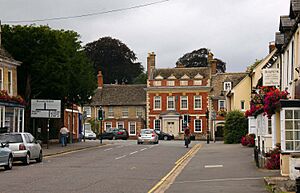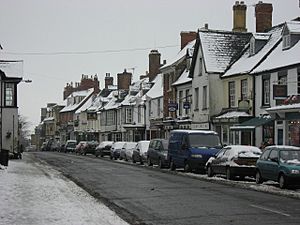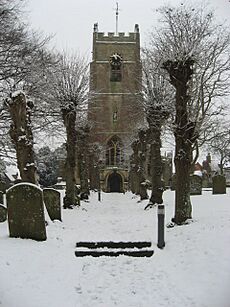Highworth facts for kids
Quick facts for kids Highworth |
|
|---|---|
 West end of the High Street, 2011 |
|
| Population | 8,258 (2021 Census) |
| OS grid reference | SU200925 |
| Civil parish |
|
| Unitary authority |
|
| Ceremonial county | |
| Region | |
| Country | England |
| Sovereign state | United Kingdom |
| Post town | Swindon |
| Postcode district | SN6 |
| Dialling code | 01793 |
| Police | Wiltshire |
| Fire | Wiltshire |
| Ambulance | Great Western |
| EU Parliament | South West England |
| UK Parliament |
|
Highworth is a historic market town and civil parish in the Borough of Swindon, England. It is located about 6 miles (10 km) north-east of Swindon town centre. In 2021, about 8,258 people lived there. The town is famous for its beautiful buildings. Many of these buildings show the Queen Anne and Georgian styles. These styles were popular when Highworth was very important in the 1700s. The town also has a church from the 1200s called St. Michael and All Angels. The parish includes the village of Sevenhampton and the small areas of Hampton and Redlands.
Contents
- Discovering Highworth's Past
- Highworth's Location and Landscape
- How Highworth is Governed
- Exploring Highworth's Landmarks
- Getting Around Highworth
- Learning in Highworth
- Churches of Highworth
- Highworth's Community and Culture
- Local News and Media
- Sports in Highworth
- Public Services in Highworth
- Famous People from Highworth
- Images for kids
- See also
Discovering Highworth's Past
Highworth is built on a hill. This high spot was very important for looking over the Upper Thames Valley. People have lived here almost continuously for 7,000 years! The town is mentioned in the Domesday Book as 'Wrde'. This name comes from an old English word meaning 'enclosure'. Back then, it had six homes and a church. The word 'High' was added around 1200 AD because of its high location.
Highworth's Market History
In 1206, Highworth was given a special permission, called a charter, for its market. This market is still held every week today. The town's original design and streets come from the Middle Ages.
Highworth During the English Civil War
During the English Civil War, Highworth was a strong place for the Royalists. But on June 17, 1645, Sir Thomas Fairfax captured it. Parliamentarian soldiers stayed there until October of the next year. During this time, a serious outbreak of the plague happened. Many traders moved their businesses to Swindon. Highworth's market did not fully recover until the late 1600s.
Growth and Change in Highworth
Highworth grew a lot during the Napoleonic Wars and the Industrial Revolution. Many of the houses in the town centre today were built during this busy time. From 1894 to 1974, Highworth had its own local government area. Now, it is part of the Borough of Swindon unitary authority. Highworth was once bigger than Swindon. At one point, Highworth's population was over 12,000 people.
Highworth's Location and Landscape
Highworth is in the north-east part of Wiltshire. It is also close to the border with Oxfordshire. The town sits on a hill above the upper Thames Valley. At 436 feet (133 meters) above sea level, it is the highest town in Wiltshire. It is about 6 miles (10 km) north-east of Swindon. London is about 69 miles (111 km) to the west.
How Highworth is Governed
The first level of local government in Highworth is the Town Council. This council has 15 elected members. Other local government jobs are handled by Swindon Borough Council. This is a unitary authority, which means it handles many different services. Three councillors are chosen to represent the Blunsdon and Highworth ward. This is a large area in the north of the borough. It includes Highworth, Inglesham, Hannington, Castle Eaton, Blunsdon, and Stanton Fitzwarren parishes. The ward is part of the Swindon North parliamentary area. Since 2024, Will Stone from the Labour Party has been the Member of Parliament for this area.
Exploring Highworth's Landmarks
The Church of England parish church of St Michael is in the middle of the town. It is at the corner of the High Street and the A361 Swindon Road. The old town centre has many beautiful Georgian and Queen Anne houses. This area has been a special conservation area since 1976. This means its historic character is protected.
The Old Manor House on the High Street is a very old building. Some parts of it date back to the late 1400s. It is listed as a Grade II* listed building, meaning it is very important historically.
Getting Around Highworth
Highworth used to be the end point of a Great Western Railway train line from Swindon. This line, called the Highworth branch line, stopped carrying passengers in 1953. It closed completely for goods in 1962. Today, the closest train station is in Swindon. It is about 6 miles (10 km) to the southwest. The main train line, the Great Western Main Line, passes about 3 miles south of the town. It goes towards Reading and London.
The A361 road goes through Highworth from north to south. The B4019 road runs from east to west through the Hampton area.
Learning in Highworth
Highworth Warneford School is a secondary school located on Shrivenham Road. Southfield Junior School is next to it. Eastrop Infant School is also nearby. Westrop Primary and Nursery School serves students on the west side of town.
Churches of Highworth
Highworth has several churches, each with its own history.
St Michael and All Angels Parish Church
A church was first mentioned in Highworth in the Domesday survey of 1086. The oldest parts of the current St Michael and All Angels church are from the 1200s. These parts suggest it was a cruciform (cross-shaped) church. The chancel has an original narrow window from the 1200s. The main part of the church, called the nave, also has arches from the 1200s. A stone carving from around 1150 is set above the south door. It might show Samson fighting a lion.
The church was updated in the late 1400s. The font, used for baptisms, is from about 1500. The detailed pulpit is from the 1600s, but it has been repaired a lot. Major repairs happened in 1861–1862. During this time, parts of the church were rebuilt. The church was given a Grade I listed status in 1955. This means it is a building of exceptional interest.
The Warnford chapel on the south side has memorials from the 1600s to 1800s. These memorials are important because they show different styles of writing. Old wall paintings were found during the 1860s repairs but were then removed.
The tall west tower has a clock and eight bells. Two of these bells were made in 1689. The tower's supports have bear and staff symbols. These are modern copies of older ones. Until the 1600s, there was also a tower where the main parts of the church crossed.
In 2018–2019, the church was closed for ten months for modern updates. Old pews and floor tiles were removed, but some tiles were kept. New heating, lighting, and an organ were installed. A kitchen and a toilet were also added.
Church History and Parishes
The church was connected to Salisbury Cathedral around 1150. Important church leaders, called prebendaries, served here.
South Marston church used to be a smaller church connected to Highworth. It became its own separate parish in 1889. Sevenhampton was also once a smaller church connected to Highworth.
Highworth, Sevenhampton, and Inglesham churches were joined together in 1940. Hannington was added in 1956. At some point, Broad Blunsdon also came under the same church leaders. Inglesham church was closed in 1980. It is now looked after by the Churches Conservation Trust. Today, the parish is called 'Highworth with Sevenhampton and Inglesham'.
Churchyard Memorials
The churchyard is full of old gravestones and tombs from the 1600s to the 1800s. The town's war memorial stands at the east entrance. It is a tall cross put up in 1921. More names were added after the Second World War.
Other Churches in Highworth
Highworth also has other churches. Two Methodist chapels were built in 1838 and 1842. The first one was too small, so a new one was built in 1856. In 1964, the two groups joined to build a bigger chapel. This church was made even larger in 1992.
The Highworth United Reformed Church is on the High Street. Highworth Community Church is an independent church. It started in 1981 and meets at different places, including Highworth Warneford School.
Highworth's Community and Culture
Highworth is connected to other towns around the world. It is twinned with Pontorson in Normandy, France, and Wassenberg in Germany. The Highworth Community Centre opened in June 2011. It is located in the building that used to be Northview Primary School.
Local News and Media
Local news and TV shows for Highworth come from BBC South and BBC West on BBC One. They also come from ITV Meridian and ITV West Country on ITV1. TV signals can be received from transmitters in Oxford or Mendip.
Local radio stations include BBC Radio Wiltshire (103.6 FM) and Heart West (97.2 FM). There's also Greatest Hits Radio South West (107.7 FM) and Swindon 105.5 (105.5 FM). Swindon 105.5 is a local radio station based in Swindon.
The local newspapers that serve Highworth are The Swindon Advertiser and the Gazette and Herald.
Sports in Highworth
Highworth has local sports teams for people to enjoy.
Highworth Town F.C. is a local Non-League football club. They play their games at the Elms Recreation Ground.
Highworth Cricket Club plays in the Wiltshire County Cricket League. They also play in the South Gloucestershire and Wiltshire Village League on Sundays. The cricket club also plays at the Elms Recreation Ground.
Public Services in Highworth
Highworth was first known as a post town in 1673. This means it had a post office. From 1835 to 1839, there was a special "Penny Post" service. This connected Highworth with Cold Harbour, a village near Broad Blunsdon. Mrs Mabel Stranks was the postmistress during the Second World War. She was a very important contact for a secret resistance group called the Auxiliary Units. A special plaque on the old post office wall remembers her important work.
Famous People from Highworth
Many interesting people have connections to Highworth:
- Samuel Wilson Warneford (1763–1855) was a generous person who gave money to good causes. His family owned a lot of land in Sevenhampton.
- Kate Lucy Ward (1829–1915), later Bridgen Carter, was a composer. She was born in Highworth.
- William Goudge (1877–1967) was a cricketer.
- Eric Buller (1894–1973) was a British Army officer and cricketer. He was born in Highworth.
- Joseph Knight (1896–1974) was also a cricketer.
- William Joscelyn Arkell (1904–1958) was a geologist and expert on the Jurassic period. He was born in Highworth.
- Helen Shapiro, a famous singer, lived in Highworth for a while after she got married.
Images for kids
See also
 In Spanish: Highworth para niños
In Spanish: Highworth para niños





